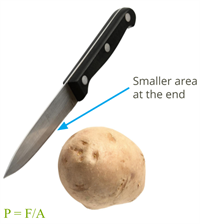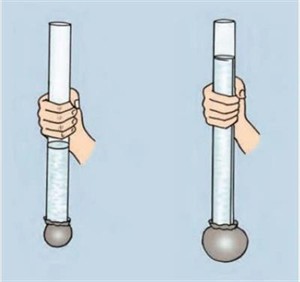On a warm evening, Emily and her twin brother Ethan went for a walk along the sandy beach. Emily wore her high-heeled sandals, while Ethan wore his wide, flat flip-flops. After only a few steps, Emily's heeled sandals started to sink deep into the soft sand. Each time she tried to lift her foot, the sand gripped her heel, making it hard to walk. But Ethan walked easily on his flip-flops.
Why did this happen?
- Both twins weigh about the same, so the force (weight) acting on the sand is nearly equal.
- But the area of contact where that force is applied is not equal.
Emily’s high heels:
- The pointed tips of the heels touch only a small area of sand.
- The same body weight (force) is concentrated on this small area, producing high pressure.
- High pressure means the sand under each heel is pressed down strongly, so the heels sink deep.
Ethan’s flip-flops:
- The broad soles touch a much wider area of sand.
- The same body weight (force) is spread over this large area, creating low pressure.
- Low pressure means the sand is pressed down lightly, so his feet stay on top of the sand.
Pressure:
Pressure is defined as the force acting per unit area on a surface, provided the force is applied perpendicularly to that surface.
\({\text{Pressure}}\) \(=\) \(\frac{\text{Force}}{\text{Area}}\)
SI unit of pressure is Newton per square metre (\(N/m²\)), also called pascal (\(Pa\)).
Important!
For the same force, pressure increases when the area decreases and decreases when the area increases.
Example:
- Snowshoes have a large area, so pressure on snow is less and people don’t sink.
- Knives, nails, and needles have very small tips, so the force acts on a small area and creates high pressure, making cutting or piercing easy.
- Tractors, bulldozers, and camels have broad feet or tyres, which spread force over a large area and prevent sinking in soil, mud, or sand.
- People carrying loads on their heads or shoulders use a folded cloth or broad strap respectively to increase area and reduce pressure.

Sharp knife

School bag with a broad strap for shoulder
Activity:
To observe how pressure depends on the area of contact.
Step 1: Take a pencil with a sharp tip and a flat back.
Step 2: Keep a piece of thermocol on the table.
Step 3: Press the sharp tip of the pencil onto the thermocol.
Step 4: Now press the flat back side of the pencil with the same force.
Observation:
The sharp tip easily goes into the thermocol, but the flat back hardly makes any mark.
The sharp tip easily goes into the thermocol, but the flat back hardly makes any mark.
Conclusion:
When the area of contact is smaller (sharp tip), the pressure is higher even with the same force. When the area is larger (flat back), the pressure is lower.
When the area of contact is smaller (sharp tip), the pressure is higher even with the same force. When the area is larger (flat back), the pressure is lower.
When Ethan returned home, he went into the bathroom to wash his feet. The moment he opened the tap, water gushed out quickly as the overhead tank was full. Later, when he filled a glass from the drinking water purifier, the water came out slowly.
Why did this happen?
- The bathroom tap receives water directly from the overhead tank, which is placed at a height.
- The greater the height of the water column, greater the water pressure at the tap. That is why water flows out quickly in the bathroom.
- The drinking water purifier, on the other hand, is usually placed at a lower level.
- Since the height of water above its tap is small, the pressure is less, and the water flows out slowly.
Important!
Water pressure increases with height.
This is the reason why water tanks are always placed at a height.
Activity:
To observe that the pressure exerted by the liquid column increases with height.

Step 1: Take four drinking straws, two of equal length but different diameters, and two of equal diameter but different lengths.
Step 2: Tie a small balloon tightly to one end of each straw so the opening is sealed.
Step 3: Hold the straws vertically with the balloon at the bottom.
Step 4: In the first setup of equal length but different diameters, fill both the straws with water and observe the size of both balloons.
Step 5: In the second setup of same diameter but different lengths, fill both the straws to the top with water and observe the size of both balloons.
Observation:
In the first setup of equal length but different diameters, both balloons bulge equally, showing that liquid pressure does not depend on the area of cross-section or the weight of water.
In the second setup of same diameter but different lengths, the balloon attached to the longer straw bulges more, showing that liquid pressure increases with the height of the liquid column.
Conclusion:
Liquid pressure depends only on the height of the liquid column and not on the size or the weight of water.
The next day, while playing , Ethan filled a bottle with water and there was a leak as there was a hole at the bottom of the bottle. Curious, he tried making another hole on the side of the bottle, and the water poured from that hole as well.
Why does this happen?
- Water exerts pressure in all directions not just downward but also sideways.
- That is why water comes out of the side of the bottle.
Activity:
To observe that liquid exerts pressure in all directions.

Ballon inside water
Step 1: Take a balloon and blow a little air into it but do not fully inflate it. Tie its mouth tightly so that air does not escape.
Step 2: Place the balloon into a transparent bucket filled with water.
Step 3: Push it down so it is fully submerged. If it tries to float up, hold it down with a string tied to a weight, so that it stays fully submerged.
Step 4: Observe the balloon’s shape from different sides, it expands slightly as it goes deeper.
Observation:
The balloon stays equally round in all directions under water because water presses on it equally from all sides that is top, bottom, and sideways.
Conclusion:
This shows that liquid exerts pressure uniformly in all directions.
Important!
Did you know the base of a dam is made much broader than the top?
This is because the base has to support the whole structure and also bear the strong water pressure at the bottom. Water stored in a dam pushes not only downward on the floor but also sideways on the walls. Since pressure increases with depth, the sideways pressure is greatest near the bottom. That’s why the base of the dam is built broader and stronger.